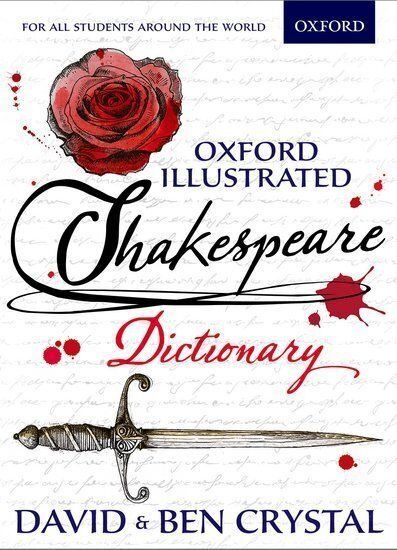If I were to choose one word to describe the Oxford Illustrated Shakespeare Dictionary, it would be - beautiful. This is one of the most beautiful books I have ever held in my hands! And as always with the Crystal standards, the quality lives up to the external splendour.
The Oxford Illustrated Shakespeare Dictionary is not Shakespeare's Words with pictures, so if you own the latter, you can still get a copy of the former. It is co-authored by David and Ben Crystal, marvellously illustrated by Kate Bellamy, published by the Oxford University Press, and is meant for students. The dictionary covers the twelfth plays most frequently turning up on curricula and course programmes - Hamlet, Henry V, Julius Caesar, King Lear, Macbeth, A Midsummer Night's Dream, The Merchant of Venice, Much Ado About Nothing, Othello, Romeo and Juliet, The Tempest and Twelfth Night.

The preliminary pages contain accessible notes on how to use the dictionary. The pages are visually inviting, colours and type adding to its far from mundane dictionary layout. Each letter starts with an illustrated head word - reminding of ABC books or illuminated manuscripts - and is further enhanced by relevant facts and tips. V, for example, is highlighted by Venice, with key information about the significance of the city to Shakespeare's time and plays.
The word definitions are as compact and lucid as possible, often defined through synonymous words. To make the usage clear, each definition is also supported by an example sentence from one of the twelve plays. My favourite bit is the smart way of pointing out Shakespeare's False Friends - a red Warning sign alerting to the differing modern meanings of the words! Dictionary writing is usually a grave matter, and to write one that packs so much information in such an accessible and visually attractive - almost, delicious - manner is an admirable accomplishment.
It is more than a dictionary. Various nuts and bolts, bits and bobs and fanciful facts about Shakespeare, his works and his world are intercalated throughout. Each letter, for example, has a section devoted to a topic - this will expand on a specific word and cover Shakespeare's use of the whole lexical field, like Family in F, Insults in I, Swearing in S, etc.
Closer to the middle of the book, the dictionary temporarily assumes a thesaurus format - that is, instead of the alphabetical order, words are defined within the framework of a common meaning, the semantic head. These are some twenty stunningly illustrated pages divided into eleven semantic fields, with several relevant words defined under each "mother" word: Armour, Swords and Daggers, Clothing, Hats, Animals, Colours, Occupations, Ships, Recreation, Music, Cosmos. The middle double-page spread of the book is shaped by a spacious map of Shakespeare's Europe and the Mediterranean, including a list of relevant countries mentioned in the canon, with their modern-day names/counterparts indicated.
Another useful feature appears at the end of the dictionary. After the letter Z, the authors provide concise and comprehensive notes on Shakespearean grammar, pronunciation, his use of French and Latin. When the week of 23 April is eventually declared as an official "Early Modern Grammar Awareness Week", you will know your thy from your thine, and your -th from your -st!
The cover tells you this is a dictionary "for all students around the world" - but if I were rich, I would buy a copy also for all the adults around the world who have had a disappointing first encounter with Shakespeare's language or none at all.
The Oxford Illustrated Shakespeare Dictionary can be obtained from the Oxford University Press and many retailers.